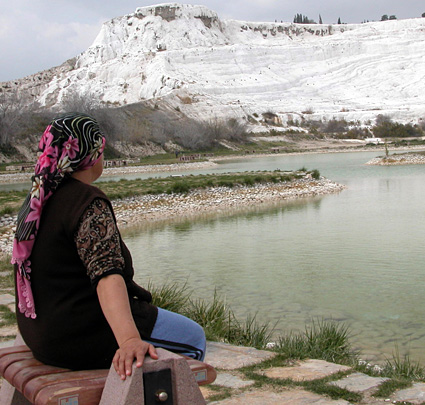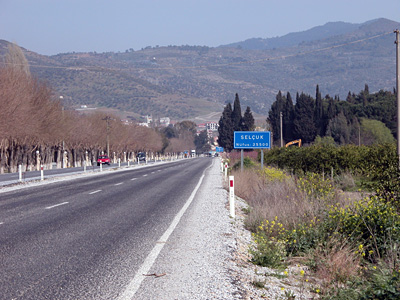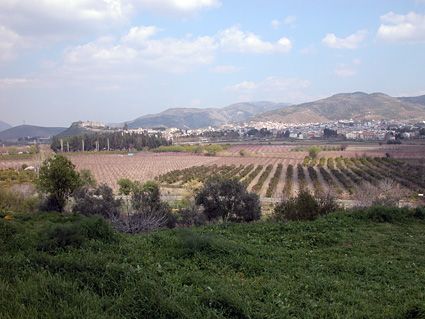Ruminations
on the pleasures of solo travel and knitting
  Nothing
is more refreshing than traveling alone. Do
not be alarmed by this statement. I am not
a reclusive anti-social hermit — quite
the opposite, in fact. But I am a knitter.
And that goes hand-in-hand with traveling alone.
Add solo travel to knitting, and the two complement
each another in such a way that brings out
the best of both. Not convinced? Here are the
perks as I see them Nothing
is more refreshing than traveling alone. Do
not be alarmed by this statement. I am not
a reclusive anti-social hermit — quite
the opposite, in fact. But I am a knitter.
And that goes hand-in-hand with traveling alone.
Add solo travel to knitting, and the two complement
each another in such a way that brings out
the best of both. Not convinced? Here are the
perks as I see them
When traveling alone,
you never have to go to the beach when you
would rather be hiking in the mountains,
or to the museum when you would rather be people
watching from a sidewalk café — or
vice versa.
Other peoples’ time
and money restraints do not affect you. And
conversely, consider if your traveling companion
had all the time and money in the world.
Ditch the companion, and you lose the temptation
to keep up with the Jones'.
My favorite reason for traveling
alone is the warmth and friendliness you receive
from fellow travelers and residents of the
place you are visiting. (This is probably just
pity on their part, but I will take what I
can get.) I have made countless friends from
across the globe that I would not have met
had I been traveling with other people.
Add knitting to that, and
you have the perfect scenario. Knitting takes
away the awkwardness of times when you would
prefer to have a traveling companion and gives
you something to do when you are feeling lonely
or tired from all that sightseeing. Just as
knitting in public is often a conversation
starter in your hometown, it works the same
way in other places, upping your potential
to meet and interact with locals or other interesting
travelers.
Last March, I took a spur-of-the-moment
solo trip to Turkey. I spent several days in
Istanbul, taking in the Byzantine, Ottoman,
and east-meets-west sights and culture there.
I kept myself so busy that I knitted for a
grand total of only 15 minutes the whole time
I was in the city. (The knitting in question
took place during one of those awkward, wish-I-had-a-companion
moments at a restaurant after I had ordered
and before the food arrived.) But four days
of the bustling big city was enough for me,
so I set out for three smaller cities scattered
about the rural western half of the country
for the rest of my trip.
  Domestic travel in
Turkey is a knitter’s
dream. The primary form of long-distance transportation
for the Turks and adventurous visitors is the
bus system. Networking across the entire country
and operated by several private companies,
the buses are much like highway taxis for the
Turks. Riders hop on and off at semi-regular
stops and at side-of-the-highway impromptu
pull-offs for would-be passengers flailing
their arms in taxi-hailing fashion. The buses
offer a cheap and efficient way for locals
to visit relatives or travel for business,
a cheap and efficient way for travelers to
see the countryside between destinations, and
a cheap and efficient way for me to get in
a lot of knitting. These buses are no Greyhounds,
either. They are clean, nice, safe, and staffed
by an attendant who comes around periodically
with snacks or a squirt of antibacterial hand
gel — quite the treat for tired knitting
hands. Domestic travel in
Turkey is a knitter’s
dream. The primary form of long-distance transportation
for the Turks and adventurous visitors is the
bus system. Networking across the entire country
and operated by several private companies,
the buses are much like highway taxis for the
Turks. Riders hop on and off at semi-regular
stops and at side-of-the-highway impromptu
pull-offs for would-be passengers flailing
their arms in taxi-hailing fashion. The buses
offer a cheap and efficient way for locals
to visit relatives or travel for business,
a cheap and efficient way for travelers to
see the countryside between destinations, and
a cheap and efficient way for me to get in
a lot of knitting. These buses are no Greyhounds,
either. They are clean, nice, safe, and staffed
by an attendant who comes around periodically
with snacks or a squirt of antibacterial hand
gel — quite the treat for tired knitting
hands.
  The conservative Turkish
culture maintains gender segregation among
unacquainted men and women in public places
like buses. And Turkish women do not travel
alone as often as the men do. The buses I
took were rarely crowded, so I usually had
the entire seat to myself for extra elbow movement.
At one point between touristy Selçuk
and industrial Denizli, I did share the seat,
and it turned out to be a fascinating cultural
experience. The conservative Turkish
culture maintains gender segregation among
unacquainted men and women in public places
like buses. And Turkish women do not travel
alone as often as the men do. The buses I
took were rarely crowded, so I usually had
the entire seat to myself for extra elbow movement.
At one point between touristy Selçuk
and industrial Denizli, I did share the seat,
and it turned out to be a fascinating cultural
experience.
The bus pulled off
the highway in one of the breakneck impromptu
stops that made me drop a stitch, lose count,
and toss my pattern across the aisle all
at once. An older Turkish woman climbed aboard
dressed in the traditional loose-fitting
pants, long sleeves, and controversial headscarf
that many older women in the conservative rural
parts of the country wear. She was accompanied
by two younger men I assumed to be her sons.
They walked the length of the bus looking for
a suitable seat for their mother. Since the
bus was somewhat crowded at this point, my
seat happened to be the only empty one next
to a female. The sons seemed less pleased about
seating their mother next to the young American
woman than I did about giving up my purling
room, but to satisfy the social custom, we
all complied. The woman settled into her seat
after a loud round of “güle
güle” (bye bye) to her sons,
they de-boarded, and we were back on our way.
  The woman and I rode
in silence for many miles — I
looking out my window and she staring straight
ahead. I waited until after the attendant came
around with another round of snacks and hand
sanitizer before getting back to my knitting.
As soon as I pulled out the project, my seat
companion perked up. She turned and watched
me for a while, and when I looked up at her,
she said “örgü.” After
some pantomiming, I understood that she was
commenting on my knitting — and later
after some research in my Turkish-English dictionary,
I found out she had been saying the Turkish
word for knitting. She continued watching me
for a while and then reached into her bag and
pulled out her own needles and yarn. It was
one of the most exquisite socks I have ever
seen. The colorwork and patterning were distinctly
Turkish, very geometric and intricate and in
rich, bold colors. Yet, she worked without
a pattern. I uttered one of the few Turkish
words I knew, “güzel,” beautiful.
We continued to knit in silence for the rest
of the ride, two women separated by age, nationality,
and custom, but connected through our mutual
handicraft. The woman and I rode
in silence for many miles — I
looking out my window and she staring straight
ahead. I waited until after the attendant came
around with another round of snacks and hand
sanitizer before getting back to my knitting.
As soon as I pulled out the project, my seat
companion perked up. She turned and watched
me for a while, and when I looked up at her,
she said “örgü.” After
some pantomiming, I understood that she was
commenting on my knitting — and later
after some research in my Turkish-English dictionary,
I found out she had been saying the Turkish
word for knitting. She continued watching me
for a while and then reached into her bag and
pulled out her own needles and yarn. It was
one of the most exquisite socks I have ever
seen. The colorwork and patterning were distinctly
Turkish, very geometric and intricate and in
rich, bold colors. Yet, she worked without
a pattern. I uttered one of the few Turkish
words I knew, “güzel,” beautiful.
We continued to knit in silence for the rest
of the ride, two women separated by age, nationality,
and custom, but connected through our mutual
handicraft.
The woman’s stop was about an hour before
mine, and as with her entrance, another “son” boarded
the bus to fetch her. Before she left, she
turned to me, smiled, and said, “güle
güle.” I watched her go and
continued my journey awed with the experience
and the knowledge — something that I
had always known deep down but never experienced
first-hand — that knitting transcends
age, cultural, and language boundaries. And
the simple act of creating something beautiful
out of nothing binds people together like yarn
in a well-knitted fabric.
|

